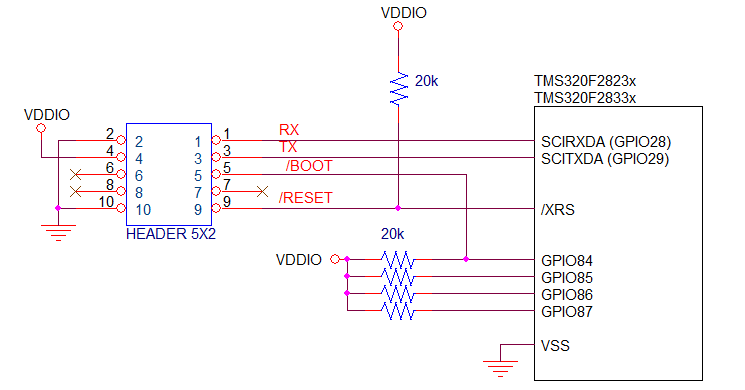
Boot mode of TMS320F2823x/2833x at reset is decided based on the pin status of four pins.
|
MODE |
GPIO87 |
GPIO86 |
GPIO85 |
GPIO84 |
Boot mode |
|
F |
1 |
1 |
1 |
1 |
Jump to Flash |
|
E |
1 |
1 |
1 |
0 |
SCI-A boot (RAM boot) |
|
D |
1 |
1 |
0 |
1 |
SPI-A boot |
|
C |
1 |
1 |
0 |
0 |
I2C-A boot |
|
B |
1 |
0 |
1 |
1 |
eCAN-A boot |
|
A |
1 |
0 |
1 |
0 |
McBSP-A boot |
|
9 |
1 |
0 |
0 |
1 |
Jump to XINTF x16 |
|
8 |
1 |
0 |
0 |
0 |
Jump to XINTF x32 |
|
7 |
0 |
1 |
1 |
1 |
Jump to OTP |
|
6 |
0 |
1 |
1 |
0 |
Parallel GPIO I/O boot |
|
5 |
0 |
1 |
0 |
1 |
Parallel XINTF boot |
|
4 |
0 |
1 |
0 |
0 |
Jump to SARAM |
|
3 |
0 |
0 |
1 |
1 |
Branch to check boot mode |
|
2 |
0 |
0 |
1 |
0 |
Branch to Flash, skip ADC calibration |
|
1 |
0 |
0 |
0 |
1 |
Branch to SARAM, skip ADC calibration |
|
0 |
0 |
0 |
0 |
0 |
Branch to SCI, skip ADC calibration |
easyDSP activates both /BOOT and
/RESET pins low for RAM booting. It activates only /RESET pin low for the
menu 'DSP>Reset DSP'.
An easyDSP uses either ‘Jump to Flash’ mode or ‘SCI-A boot’ by setting GPIO84
pin as 1 or 0 while other three pins are fixed to 1. Therefore below circuit configuration is
recommended.

- power pin (#4) of
easyDSP 5x2 header should be connected to 3.3V
- TX/RX
pins are directly connected to MCU
pins
- In case
there is a reset IC between easyDSP /RESET and MCU /XRS, it should transfer
easyDSP /RESET signal to MCU /XRS within 0.5sec
- In case you insert buffer IC between easyDSP
header and MCU, place buffer IC directly to easyDSP header so that all resistors
can be connected to directly MCU
- /RESET pin is connected to
reset generation circuit of MCU
board
(Time duration of /Reset pin is around 500msec)
- In case you use pull-up resistor to each pin, the value
of pull-up resistor should be higher than a few kilo ohm since there is 100Ω
series resistor inside easyDSP pod
- You can use the boot pins (GPIO84 to GPIO87) in
your program
Please be careful when you use
your own pull-up or pull-down resistor on the easyDSP signal pins. Please use
appropriate filter circuit to your reset generation circuit to prevent
unintentional reset generation.